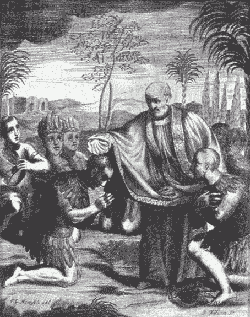 As readers of this blog know I have a series of posts, Jesuitical, in which I have highlighted follies of some modern day Jesuits. This series will put the spotlight on great Jesuits of the past and present. First up is Father Andrew White, SJ.
As readers of this blog know I have a series of posts, Jesuitical, in which I have highlighted follies of some modern day Jesuits. This series will put the spotlight on great Jesuits of the past and present. First up is Father Andrew White, SJ.
Born in 1579 in London, he followed the well worn path of many English Catholics of the period to study for the priesthood at the English seminary in Douai, France. Continuing his studies at St. Alban’s College in Valladolid, Spain, he was ordained at Douai in 1605. Returning to England as an undercover mission priest, he was arrested in the persecution that occurred after the Gunpowder Plot and was exiled from England in 1606. He joined the Society of Jesus in 1607. Defying a death sentence hanging over his head, he continued to visit Southern England to say clandestine masses and to preach to the faithful. He also served as prefect at the seminaries of Leuven and Liege.
Father White was instrumental in the conversion of George Calvert to Catholicism in 1625. Calvert was a truly remarkable man, a favorite of James I, who sacrificed a promising career in English government by publicly declaring his Catholicism at a time when being a Catholic in England was a criminal offense. After his conversion his main goal in life was to create a colony where English Catholics could worship freely. He established a small colony called Avalon in Newfoundland for Catholics in 1627. Appalled by the rough climate of Newfoundland, and the author of this post knows from first hand experience how rough that climate can be, he sought and received lands from Charles I that became the foundation of Maryland. Like Moses, Calvert was not fated to enter the promised land, dying in 1632. Fortunately he had a Joshua in his son Cecilius Calvert, who carried on with the colonization project, paying out of his pocket the sum of 40,000 pounds which would have a current value of approximately 8,000,000.00 dollars. Under his brothers George and Leonard, the colonists, a mixed group of Protestants and Catholics, the Calverts emphasized that their colonly would be a bastion of religious tolerance, sailed in The Ark and The Dove on November 22, 1633 (Old Style) from the Isle of Wight for America. Father White sailed with them.
Father White has left an account of the voyage which may be read here. On March 25, 1634, the Feast of the Annunciation, on Saint Clement’s Island, Father White said the first mass in the English North American colonies. Over the next decade Father White established a successful Jesuit mission in Maryland, being eventually joined by three other Jesuit priests. He did not restrict his ministrations to the English Catholics, but also was a tireless apostle to the local Indians. His efforts were crowned by the conversion of Chitomachon, the chief of the Piscataway Indians, to the Faith. He composed a grammar, dictionary and catechism in the Indian dialect. He also found time to write the first history of Maryland.
The English Civil War put an end to Father White’s good work. Richard Ingle seized the colony for Parliament and shipped Father White back to England in chains in 1645. He was held in Newgate Prison until 1648. Placed on trial for returning to England after being banished in 1606, with considerable verve he successfully defended himself by contending that he obviously had no choice in returning to England as the chains he wore on his return indicated. After his release Father White constantly petitioned the government to return to his beloved Maryland, but the government of Oliver Cromwell had no intention of allowing him to spread Catholicism in Maryland. Father White died on December 27, 1656 in England.

A cross carried on either the Ark or the Dove is hanging at Dahlgren Chapel at Georgetown.
I encourage you to include the recently deceased Fr. Thomas King, a Georgetown Jesuit (one of them!) who founded University Faculty for Life. His obituary here (http://www.washingtonpost.com/wp-dyn/content/article/2009/06/27/AR2009062702307.html) doesn’t cover his most powerful trait: his holiness: somewhat recounted here (http://jesuitjoe.blogspot.com/2009/06/adieux.html), here (http://www.firstthings.com/blogs/firstthoughts/2009/06/25/thomas-king-s-j-%E2%80%93-an-enchantment/), and here (http://www.firstthings.com/blogs/firstthoughts/2009/06/24/fr-thomas-king-s-j-1929-2009/).
He is on my list Zak. Thank you!
[…] 2 of my series on great Jesuits in American history. Ireland has given many great gifts to the United States of […]
[…] Number 5 in my series on Great Jesuits of American history. A hallmark of the Jesuit Order has always been utter fearlessness. The Order founded by that Basque soldier turned saint, Saint Ignatius Loyola, had as little use for fear as it did for doubt. The “black robes” of the Jesuits in New France were typical of the Jesuit soldiers of Christ in their almost super-human courage in disdaining the torture and death they exposed themselves to as missionaries to warlike tribes. […]
[…] Number 6 in my series on great Jesuits of American history. Pierre-Jean De Smet first saw the light of day in Dendermonde in Belgium on January 30, 1801. His parents would have been astonished if they had been told that in his life their newborn would travel over 180,000 miles as a missionary, and most of it in the Wild West of the United States. […]